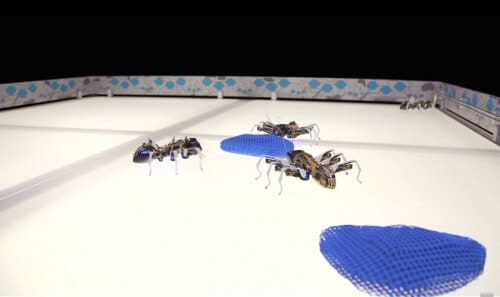The family of robotic animals, created by the German company Festo, has grown. As part of the Biomimetic Learning Network, the company introduced three new robots: a swarm of ants that can work cooperatively, a butterfly robot that flies with the lightness of an insect, and a robotic grasping arm based on the tongue of a chameleon.

By: Yuval Sherman
The family of robotic animals, created by the German company Festo, has grown. As part of the Biomimetic Learning Network, the company introduced three new robots: a swarm of ants that can work cooperatively, a butterfly robot that flies with the lightness of an insect, and a robotic grasping arm based on the tongue of a chameleon.
The bionic ant, called BionicANTS, was inspired not only by the physical shape of the insect's body, but also by its swarm intelligence. For the first time, the cooperative behavior of the creatures was also transferred to the world of technology through complex control algorithms.
"Like their natural imitation model, the bionic ants work together under clear rules," Pesto says. "They communicate with each other and coordinate their actions and movements. Each ant makes its decisions independently, but it is always subordinate to the common goal and thus it fulfills its duties for the purpose of carrying out the task".
Each such ant, which is 13.5 cm in size, is visually breathtaking, when all its electrical circuits are embedded on top of the external structure, and are used as part of its design, and not for function alone.
A radio module in the ant's abdomen allows the ants to communicate with each other, and piezo-ceramic devices (which produce mechanical movement as a result of electrical voltage, without the use of a motor) allow the legs and pincers to work quickly and accurately. A 40D camera on the ant's head allows it to see, and an infrared optical sensor on its bottom registers the distance it covers on the floor. Two lithium batteries provide up to XNUMX minutes of energy for independent operation, before the ants will reach their charging station by themselves, to which they will connect using their tentacles.
More details on the bionic ports
The flight of the delicate butterflies, called EMotionButterflies, is also coordinated through a smart network system. "Aviation is a recurring motif in the bionic learning network," says Festo. "The developers used the knowledge they gained from previous projects that dealt with aviation, and combined the ultra-light structure of artificial insects with the behavior of coordinated flight in a swarm."
The system consists of ten high-speed infrared cameras, installed in the space where the butterflies fly. The cameras follow infrared markers on the robotic butterflies, transmitting real-time data to a central main computer, which centralizes the movements of the butterflies, and prevents them from colliding with each other - quite an achievement, considering the butterflies' 50-centimeter wingspan.
Each butterfly weighs only 32 grams, and includes two servo motors, an electronic circuit and two small lithium batteries, all packed into a tiny body. The batteries are only enough for four minutes of flight, with a charging time of 15 minutes.
"With these butterflies, the Pesto company takes another step in the field of miniaturization, light construction and functional integration. The robotic butterflies are impressive, they have a clever mechanical system and the smallest possible power unit in the most limited space. Reducing the use of materials enables aviation behavior that is faithful to nature", says Festo.
More details and a video clip about the robotic butterflies
Like all Festo robotic animals, it is likely that these too will not reach serial production, and will be used for the development of industrial robots in the future. In contrast, the following development is very useful in the company's industrial robots.
This is a robotic arm, capable of grasping a very wide variety of objects, with great precision and delicacy. The arm is based on the impressive grasping ability of the chameleon's hunting tongue. The chameleon is able to catch a wide variety of insects by wrapping them in its tongue. The FlexShapeGripper device uses this principle to grip the widest variety of objects in a way that fits their shape. By using an elastic silicone cover, the device can even pick up several objects together and place them back in one movement.
This project is the result of a collaboration between Pesto and the University of Oslo, and it shows that Pesto uses biomimicry as an innovation engine to develop solutions for industrial automation.
More details and a video clip - on the website of the Pesto company.

2 תגובות
oracle
Considering that some of the most sophisticated robots today are used to kill humans, and it doesn't look like that will change in the near future, I don't foresee your request coming true anytime soon. The good news about this is that at least they are not yet functioning completely independently.
Asimov's laws of robotics must be embedded in every robot before it is too late.
When a robotic ant is programmed to build more ants and in a war to kill that is the end.